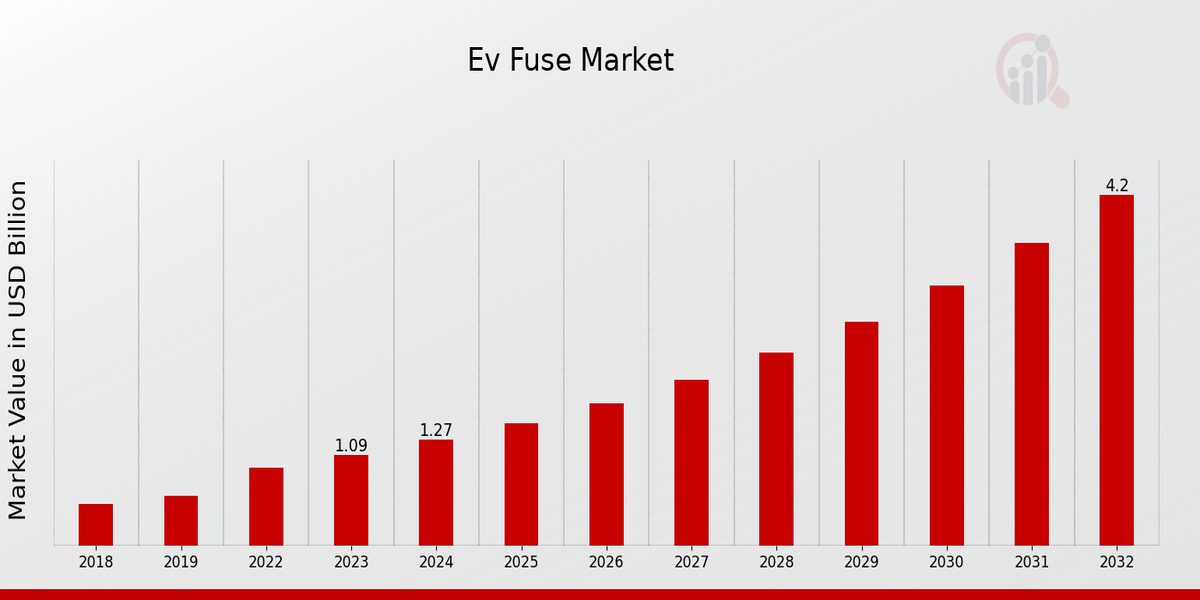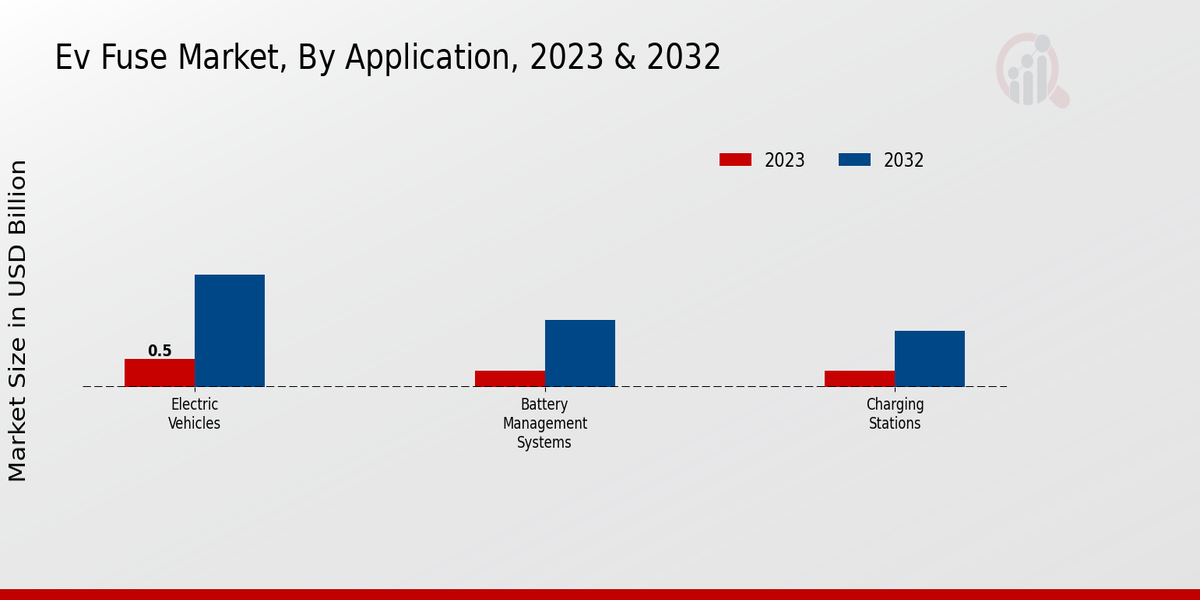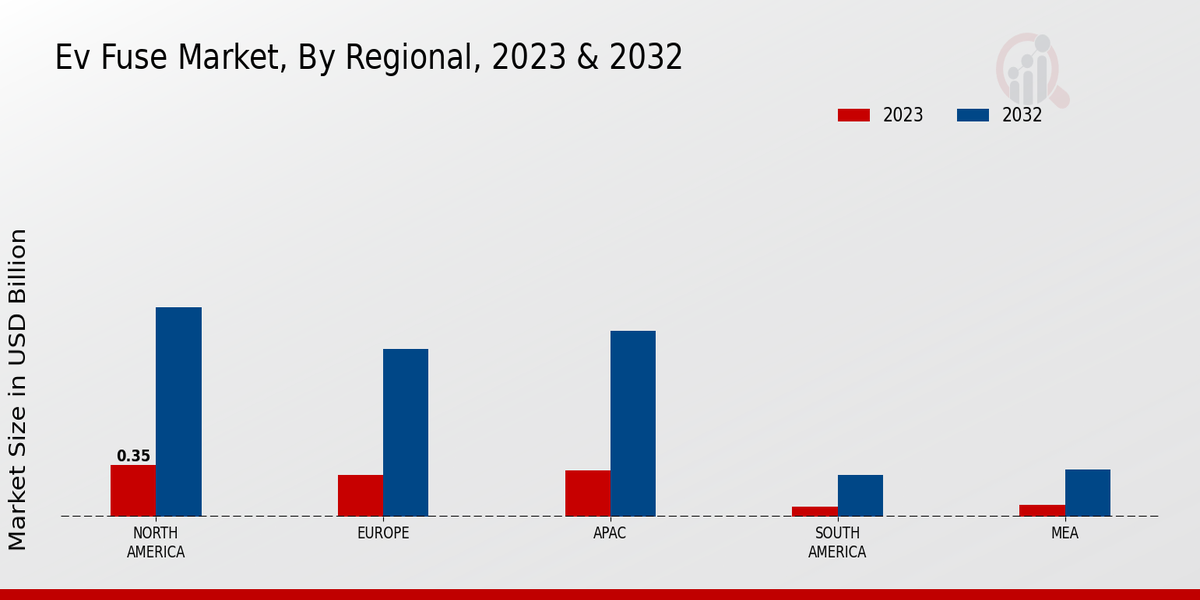EV Fuse Market Overview
As per MRFR analysis, the EV Fuse Market Size was estimated at 1.47 (USD Billion) in 2024. The EV Fuse Market Industry is expected to grow from 1.71 (USD Billion) in 2025 to 6.58 (USD Billion) till 2034, at a CAGR (growth rate) is expected to be around 16.15% during the forecast period (2025 - 2034).

Source Primary Research, Secondary Research, MRFR Database and Analyst Review
Key EV Fuse Market Trends Highlighted
The EV Fuse Market is experiencing significant growth, driven by several key factors. One of the primary market drivers is the increasing adoption of electric vehicles across the globe, fueled by government initiatives to reduce carbon emissions and promote sustainable transportation. As electric vehicles become more mainstream, there is a rising demand for components that ensure safety and reliability, thus elevating the need for innovative fuse solutions. Additionally, the rapid advancements in battery technology and the growing focus on vehicle performance further stimulate the market. Opportunities within this market are notably vast as manufacturers seek to develop more efficient and compact fuse solutions to cater to the evolving needs of electric vehicles.
Customization and adaptation of fuses for various applications, including energy storage systems and charging stations, present substantial growth potential. The integration of smart technologies into electric vehicles also opens avenues for enhanced fuse designs that can monitor and mitigate electrical faults more effectively. In recent times, a noticeable trend has been the focus on sustainability and eco-friendly practices within the automotive sector. Companies are increasingly investing in research and development to produce fuses made from recyclable materials or those that minimize environmental impact. The trend of electric vehicle electrification continues to drive the demand for specialized fuses that can handle high voltage and current scenarios safely.
As the industry evolves, collaboration among stakeholders, including automotive manufacturers and electronic component suppliers, is becoming more common, enabling the development of advanced solutions that meet the specific requirements of modern electric vehicles. This collaborative approach highlights the dynamic nature of the EV Fuse Market and its potential for continued growth.
EV Fuse Market Drivers
Rising Adoption of Electric Vehicles (EVs)
The increasing adoption of electric vehicles is one of the most significant drivers for the EV Fuse Market Industry. As governments around the world set ambitious targets for reducing carbon emissions and transitioning to cleaner transportation, the demand for electric vehicles continues to grow. Consumers are increasingly aware of the environmental benefits of electric vehicles and are choosing them over traditional combustion engine vehicles.
The growth of the EV market creates a corresponding need for specialized components, including fuses that can manage the unique electrical demands of electric vehicles. These fuses play a critical role in ensuring the safety and reliability of EVs by preventing electrical failures and protecting sensitive components from overloads. Furthermore, as more manufacturers enter the EV space, there is a growing requirement for diverse fuse solutions that can cater to different vehicle models and configurations.
This rising adoption drives innovation in fuse design and materials, expanding the overall market. As the industry evolves, the integration of smart technologies into fuses is also increasingly prominent, offering features like enhanced monitoring and diagnostic capabilities that appeal to modern consumers. The surge in electric vehicle infrastructure development, including charging stations, also contributes to the need for reliable fuse solutions.
Overall, with projections indicating significant growth in electric vehicle sales, the EV Fuse Market Industry stands to benefit immensely from this trend, positioning itself as a key player in the wider transition to sustainable transport.
Technological Advancements in Fuse Manufacturing
Technological advancements in fuse manufacturing are revolutionizing the EV Fuse Market Industry. Innovations in materials science and engineering have led to the development of fuses that can withstand higher voltage and current ratings required by electric vehicles. These advancements not only improve the performance of fuses but also enhance their reliability, safety, and longevity. As manufacturers leverage cutting-edge technology, there is a heightened demand for advanced fuse solutions that can cater to the unique needs of modern electric vehicles.
As electric vehicles feature more complex electrical systems, the evolution of fuses becomes critical to maintaining system integrity and performance.
Government Initiatives and Regulatory Support
Government initiatives and regulatory support significantly contribute to the growth of the EV Fuse Market Industry. Many countries are implementing favorable policies and incentives to encourage the adoption of electric vehicles, which in turn drives demand for related components like fuses. Financial incentives, grants, and subsidies for EV buyers are creating a conducive environment for market growth. Furthermore, regulatory bodies are setting stringent safety standards for electric vehicles, necessitating the use of advanced fuses to comply with these regulations.
This regulatory framework promotes innovation and the development of high-performance fuses tailored for electric vehicle applications.
EV Fuse Market Segment Insights
EV Fuse Market Application Insights
The EV Fuse Market is experiencing substantial growth, particularly within the Application segment, which encompasses crucial areas such as Electric Vehicles, Battery Management Systems, and Charging Stations. In 2023, this segment contributed to a market value of 1.09 USD Billion, reflecting the increasing integration of fuses in various applications essential for electric mobility and energy management. Among these applications, Electric Vehicles hold a majority share with a valuation of 0.5 USD Billion, expected to significantly grow to 2.0 USD Billion by 2032, demonstrating the critical role fuses play in safety and performance enhancement for electric vehicles.
Battery Management Systems follow closely, beginning at 0.3 USD Billion in 2023 and projected to rise to 1.2 USD Billion in 2032, as these systems are vital in optimizing battery performance and lifespan, further driving the electric vehicle market growth. Charging Stations, while currently representing a smaller share at 0.29 USD Billion in 2023, are set to expand to 1.0 USD Billion by 2032, highlighting the growing need for reliable safety mechanisms in charging infrastructure as the demand for electric vehicles accelerates. The overall growth in the EV Fuse Market revenue reflects significant trends toward renewable energy usage and stringent safety regulations across the automotive industry.
As electric mobility becomes increasingly prioritized by consumers and governments alike, the importance of reliable fuses within these applications becomes clear, driving innovation and investment in this market segment. The market also faces challenges such as supply chain disruptions for components and the need to meet varying safety standards globally, yet it presents ample opportunities for growth as technological advancements in electric vehicle usage continue to unfold. The insight from this market data emphasizes not only the growing demand for Electric Vehicles but also the substantial impact Battery Management Systems and Charging Stations have in shaping the evolving landscape of the EV Fuse Market industry.

Source Primary Research, Secondary Research, MRFR Database and Analyst Review
EV Fuse Market Type Insights
The EV Fuse Market is projected to reach a value of 1.09 billion USD by 2023, showcasing a robust growth trajectory. This market is primarily delineated by the types of fuses that are pivotal in maintaining the safety and efficiency of electric vehicles. High Voltage Fuses play a crucial role in protecting high-capacity battery systems, while Low Voltage Fuses are essential for various automotive electronic components. Medium Voltage Fuses, on the other hand, are significant in handling the intermediate power needs between high and low voltage systems, ensuring reliable operation.
The demand for these fuses is driven by the increasing adoption of electric vehicles and the need for reliable electrical protection. As per the EV Fuse Market statistics, the growth in the EV sector catalyzes advancements in fuse technology, addressing safety concerns and enhancing vehicle performance. Challenges such as technological advancements and the need for compatible designs remain, yet the opportunities for innovation in these fuse technologies continue to evolve, shaping the future of the EV Fuse Market revenue and segment dynamics.
EV Fuse Market End Use Insights
The EV Fuse Market, valued at 1.09 billion USD in 2023, is experiencing robust growth across various segments. The End Use segment showcases diverse applications that cater to a broad spectrum of electric vehicles. Among these, Passenger Vehicles hold a major share, significantly impacting the EV Fuse Market revenue due to the increasing adoption of electric passenger cars worldwide. Commercial Vehicles are also gaining traction, driven by the need for sustainable transportation solutions in urban settings, while Two-Wheelers exhibit notable growth as urban mobility trends shift towards electrification.
The EV Fuse Market statistics reflect the urgent demand for reliable and efficient electric fuses in these applications, fueled by government incentives and technological advancements. With rising awareness of environmental issues, the market growth is propelled by the increasing need for smart and safe charging infrastructure in the EV sector. The market faces challenges, such as standardization and supply chain issues, but opportunities abound for innovation and expansion in response to evolving consumer preferences. This dynamic landscape underscores the significance of the End Use segment in shaping the future of the EV Fuse Market industry.
EV Fuse Market Material Type Insights
The EV Fuse Market has shown significant growth, with a total market value expected to reach 1.09 billion USD by 2023. Among the various material types, Ceramic, Plastic, and Glass each play crucial roles in shaping this market's dynamics. Ceramic is known for its durability and heat resistance, making it a reliable choice for high-performance electric vehicles. Plastic, with its lightweight and cost-efficiency, caters to a wider range of applications, thereby gaining popularity among manufacturers aiming for greater efficiency. Glass, while less common, offers unique benefits such as transparency and electrical insulation properties, which contribute to specific use cases in the EV industry.
The combination of these material types contributes to the overall market growth, driven by the increasing adoption of electric vehicles and a growing focus on safety standards. Insights from EV Fuse Market data indicate that as the demand for efficient, safe, and lightweight components rises, the advancements in these materials will further enhance their significance within the market. The interplay between these materials will shape the EV Fuse Market segmentation, presenting both opportunities and challenges in meeting the evolving automotive standards and consumer demands.
EV Fuse Market Regional Insights
The EV Fuse Market is projected to experience substantial growth across various regional segments. In 2023, North America is expected to hold a significant market value at 0.35 USD Billion, and by 2032, it is forecasted to reach 1.4 USD Billion, demonstrating a strong inclination toward electric vehicle adoption and infrastructure development. Europe follows closely, with a valuation of 0.28 USD Billion in 2023, projected to grow to 1.12 USD Billion by 2032, indicating a robust focus on sustainability and renewable energy sources. The APAC region stands at 0.31 USD Billion in 2023 and is anticipated to increase to 1.24 USD Billion in 2032, reflecting the region's dominance in manufacturing electric vehicles and accompanying components.
South America, though currently smaller, with a market valuation of 0.07 USD Billion, is estimated to grow to 0.28 USD Billion, showcasing potential in emerging markets. Meanwhile, the MEA segment, valued at 0.08 USD Billion in 2023, is projected to expand to 0.32 USD Billion, driven by growing investments in electric mobility solutions. Collectively, these regions illustrate the diverse landscape of the EV Fuse Market, highlighting North America's and Europe's majority holding and significant contributions to market growth.

Source Primary Research, Secondary Research, MRFR Database and Analyst Review
EV Fuse Market Key Players and Competitive Insights
The EV Fuse Market has experienced significant growth in recent years, driven by the increasing adoption of electric vehicles and the need for advanced safety measures in battery management systems. As the market expands, it is becoming increasingly competitive, with various key players utilizing innovative technologies, expanding their product offerings, and focusing on sustainability to capture market share. This is further propelled by the rising demand for robust and efficient fuse solutions that cater specifically to the unique challenges presented by electric vehicle systems. With a focus on performance, safety, and reliability, companies in the sector are strategically positioning themselves to address the evolving needs of manufacturers and consumers in the electric vehicle space, thereby enhancing their competitive advantage within the market.
Littelfuse has established itself as a prominent player in the EV Fuse Market, recognized for its comprehensive range of fuse solutions designed for electric vehicles. The company capitalizes on its extensive engineering expertise and innovative approach to develop high-performance fuses that ensure the safety and longevity of EV systems. Littelfuse’s commitment to research and development allows for the continuous improvement and enhancement of its product offerings, catering to the growing requirements of manufacturers in the electric vehicle sector. With a strong presence and a network of distributors and partners, Littelfuse effectively supports its customers while maintaining a reputation for quality and reliability in the competitive landscape of electric vehicle fuses.
Bel Fuse has carved a niche for itself within the EV Fuse Market by focusing on providing high-quality fuse solutions tailored to the specific demands of electric vehicles. The company boasts a diverse portfolio of products aimed at ensuring safety, efficiency, and performance in electric vehicle applications. Bel Fuse's strong emphasis on innovation and technology development allows it to stay ahead of market trends and cater to the evolving needs of OEMs and automotive suppliers. The company's established reputation for reliability and customer satisfaction positions it favorably in the competitive environment of the EV fuse market, enabling it to foster long-term relationships with stakeholders in the industry while contributing to the advancement of electric vehicle technologies.
Key Companies in the EV Fuse Market Include
-
Littelfuse
-
Bel Fuse
-
Mersen
-
Honeywell
-
Mitsubishi Electric
-
Fuseco
-
TE Connectivity
-
Eaton
-
General Electric
-
SIBA
-
Phoenix Contact
-
ABB
-
Schneider Electric
-
Siemens
-
Rockwell Automation
EV Fuse Market Industry Developments
The EV Fuse Market is witnessing significant developments, primarily influenced by the accelerating demand for electric vehicles. Companies like Littelfuse and Bel Fuse are innovating to enhance the efficiency and safety of their fuse technologies, catering to the evolving needs of EV manufacturers. Additionally, Mersen and Honeywell are actively expanding their portfolios to address specific applications within the electric vehicle sector. There has also been notable activity in mergers and acquisitions, enhancing competitive positioning and technological advancements. For instance, Schneider Electric has pursued strategic alliances to enhance its capabilities in energy management technology. This dynamic landscape is further bolstered by the expansion initiatives of major players like TE Connectivity and Eaton, aimed at increasing production capacity to meet rising market demands. The market valuation is growing, driven by investments and collaborations among key players like Mitsubishi Electric and ABB, indicating a commitment to advancing the infrastructure necessary for supporting electric mobility. This collaborative environment among giants such as Siemens, General Electric, and Rockwell Automation is fostering innovation and positioning the EV Fuse Market for substantial growth in the upcoming years.
EV Fuse Market Segmentation Insights
EV Fuse Market Application Outlook
Electric Vehicles
Battery Management Systems
Charging Stations
EV Fuse Market Type Outlook
High Voltage Fuses
Low Voltage Fuses
Medium Voltage Fuses
EV Fuse Market End Use Outlook
Passenger Vehicles
Commercial Vehicles
Two-Wheelers
EV Fuse Market Material Type Outlook
Ceramic
Plastic
Glass
EV Fuse Market Regional Outlook
North America
Europe
South America
Asia Pacific
Middle East and Africa
| Report Attribute/Metric |
Details |
|
Market Size 2024
|
1.47 (USD Billion)
|
|
Market Size 2025
|
1.71 (USD Billion)
|
|
Market Size 2034
|
6.58 (USD Billion)
|
|
Compound Annual Growth Rate (CAGR)
|
16.15% (2025 - 2034)
|
|
Report Coverage
|
Revenue Forecast, Competitive Landscape, Growth Factors, and Trends
|
|
Base Year
|
2024
|
|
Market Forecast Period
|
2025 - 2034
|
|
Historical Data
|
2019 - 2023
|
| Market Forecast Units |
USD Billion |
| Key Companies Profiled |
Littelfuse, Bel Fuse, Mersen, Honeywell, Mitsubishi Electric, Fuseco, TE Connectivity, Eaton, General Electric, SIBA, Phoenix Contact, ABB, Schneider Electric, Siemens, Rockwell Automation |
| Segments Covered |
Application, Type, End Use, Material Type, Regional |
| Key Market Opportunities |
Rising EV adoption rates, Regulatory support for EVs, Advanced fuse technologies development, Growing demand for safety solutions, Electrification of transportation infrastructure |
| Key Market Dynamics |
growing EV adoption, technological advancements, regulatory support, increasing safety standards, charging infrastructure expansion |
| Countries Covered |
North America, Europe, APAC, South America, MEA |
Frequently Asked Questions (FAQ) :
The EV Fuse Market is expected to be valued at 6.58 billion USD in 2034.
The expected CAGR for the EV Fuse Market from 2025 to 2034 is 16.15%.
North America is expected to dominate the EV Fuse Market, projected to reach 1.4 billion USD by 2032.
The market size for Electric Vehicles in the EV Fuse Market is expected to reach 2.0 billion USD by 2032.
Key players in the EV Fuse Market include companies like Littelfuse, Bel Fuse, Mersen, and Honeywell.
The projected market size for Charging Stations in the EV Fuse Market is expected to be 1.0 billion USD by 2032.
The expected market size of the EV Fuse Market in North America in 2023 is 0.35 billion USD.
The market for Battery Management Systems is projected to be valued at 1.2 billion USD in 2032.
The market size of the EV Fuse Market in the APAC region is expected to reach 1.24 billion USD by 2032.
The EV Fuse Market faces challenges such as supply chain disruptions and the need for technological advancements.

















